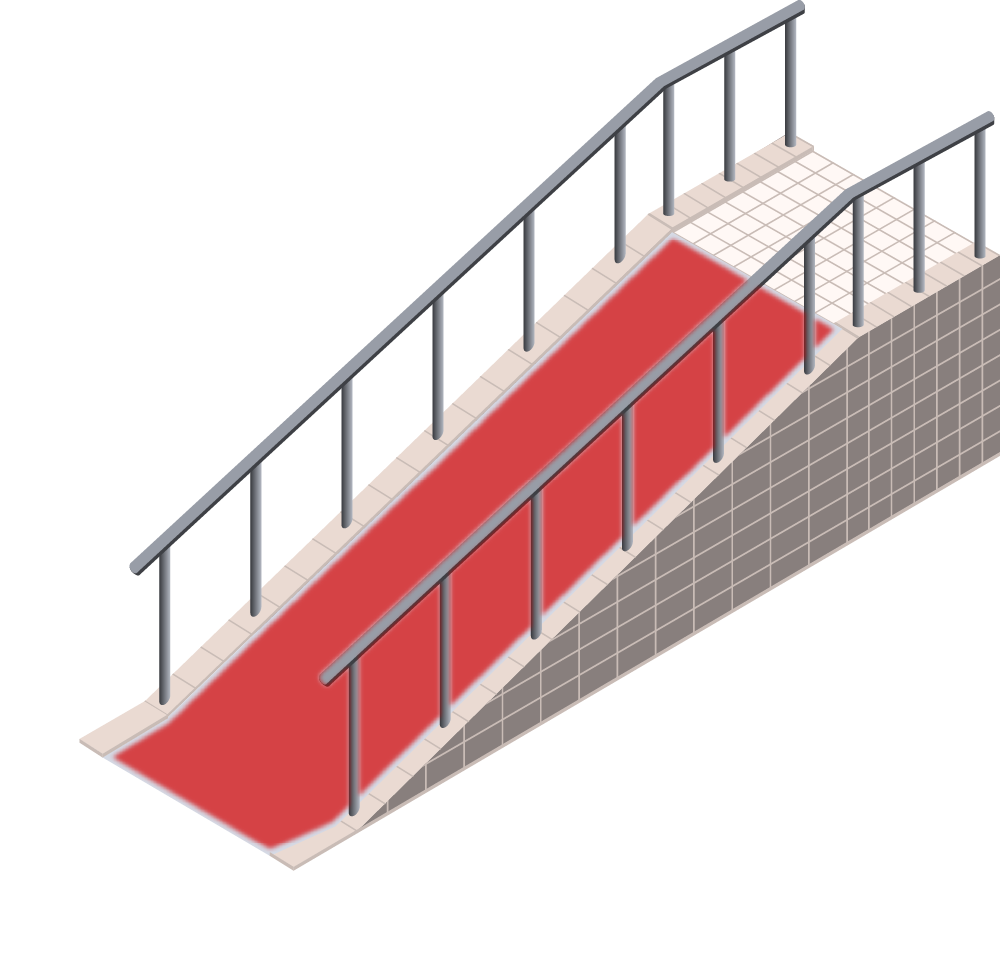REDUCE SLIP, TRIP & FALL ACCIDENTS ON RAMPS AT HOME OR WORK
According to the US Census Bureau, 12.6% of adults in the US have an ambulatory disability that makes it difficult for them to climb stairs. This has led to an increase in the number of ramps and inclined surfaces being installed in public and commercial places as well as in homes across the United States. As the population continues to age, we are likely to see more ramps in the future.
While ramps can significantly increase mobility, walking on a slope requires you to change your posture. Your center of gravity shifts, and the angle of your ankle when you step changes to accommodate the slope. Gravity will pull you down the slope, creating a new slip and fall hazard. To add to the problem, many of these ramps are outside and they’re usually open to the elements like rain and snow.
Below are recommendations to prevent slips and falls while walking up or down a ramp, as well as steps that can be taken to mitigate the inherent risks of ramps in residential and commercial locations.

PREVENTION
- Pay Attention and Slow Down: Knowing that a ramp is going to throw off your balance should prompt you to walk slower and take smaller steps when on a ramp. When the ramp is dirty, wet, or icy, it will be more slippery and more dangerous, so it’s important to take each step with care.
- Be Careful When Carrying Items: Being careful on ramps or stairs when carrying anything is a universal prevention measure. Any time your attention is split between what you’re holding and where you are walking, you are at risk for a slip or fall. Your weight distribution and balance are affected, and the greater physical effort can result in muscle failure. Of course, your hands aren’t available to hold onto the handrails and your view of the ramp may be blocked by the object you’re carrying. Making multiple trips with smaller and lighter loads will make you safer.
- Use Handrails When Available:Even if you’re fully mobile, keeping a hand on the rail provides another point of contact, increasing stability and providing a way to recover if you should stumble. Handrails are so effective in minimizing falls that many governmental agencies require handrails on ramps. If you have a ramp at the entrance of your home or commercial building, make sure that you also have a sturdy handrail installed with it.
MITIGATION
You can mitigate the slip, trip, and fall risk on ramps by mitigating design, construction, and material flaws that can often lead to injuries. You can also reduce risk by mitigating the environmental conditions that encourage falls.
- Improve Traction: If you are located in a location that receives snow in the winter, or frequent wet conditions cause algae or mold to grow on your ramp, installing traction tools, like aluminum HandiTreads, will greatly increase the traction and safety factor for both pedestrians and those in wheelchairs. HandiTreads are a permanent lifelong solution, so they will not need to be replaced after initial installation. Click here to learn more about the features and benefits of HandiTreads.
- Install Handrails: As stated above in the prevention section, ramps should always have a well-secured handrail, if at all possible. Using a handrail while ascending or descending a ramp provides an extra point of contact and stability that reduces the chance of slipping and falling.
- Ensure the Ramp is in Good Shape: As with any structure, ensuring that the ramp itself is in good shape is the first step towards minimizing the risk of slip, trip, or fall hazards. Wood planks that are uneven or delaminating can easily catch a toe, causing someone to stumble. If your wood ramp is deteriorating, aluminum HandiTreads can act as a way to safely increase their useful life by protecting the edges of the boards and reinforcing the construction of the ramp.
- Correct, ADA Compliant Ramp Slope: The Americans with Disabilities Act requires that the vertical rise of a ramp be no more than one inch for every twelve inches of length. This 1:12 slope suggests that if your ramp needs to rise from ground level to a porch or business entrance two feet off the ground, the ramp length must be 24 feet in length.
- Keep the Ramp Free of Ice and Snow: While ramps can be built out of many materials, most are made of wood, concrete, or metal. Understanding the hazards inherent to each type of material can help to keep you, your family, and/or your customers or employees safe. Wood ramps will absorb water and tend to be slippery when wet; they also become very slippery when covered with snow or ice. Concrete ramps should have proper drainage to prevent water accumulation. Metal ramps should have a non-slip pattern built into their walking surface. Using salt or another deicer during the winter months can help keep your ramp ice-free. To prevent your ramp from becoming unsafe in weather conditions like rain or snow, you can apply slip and fall prevention products like HandiTreads to make it safer. The treads create a solid contact between shoe and ramp, even up to one inch of snow, preventing slips, trips, and falls. If there is a large amount of snow accumulated on the ramp, you can remove it using a snow shovel (without a metal edge) to clear the threads of deep snow and increase the safety of the ramp.
